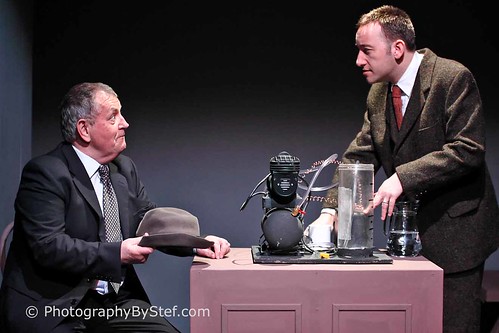Review – The Water Engine
✭✭✭✩✩ Complex
St Ninian’s
Mon 8 – Sat 13 April 2013
Review by Thom Dibdin
Menacing and dark, Edinburgh Theatre Arts production of the Water Engine at St Ninian’s Hall, Comely Bank, finds the thrill in David Mamet’s examination of corporate greed.
Set in 1934, during the Chicago Century of Progress Exposition, the play follows the attempts by inventor Charles Lang (David McCallum) to get a patent for his revolutionary new engine which runs on water.
Mamet sets up a backdrop of poverty at the time of America’s great depression, with the wonder of the science fair put against the superstition of the chain letter phenomena which had begun to sweep the country at the time – and chorus of street people shouting their own beliefs.
But it is in Lang’s tale – brought to the stage with simplicity and a sense of film noir paranoia by McCallum – that this examines the dark side of capitalism. Verity Simpson provides an extra edge as Lang’s fearful, blind sister Rita, constantly worried of a “them” who will be out to steal and benefit from his wondrous invention.
Well she might be. John McLinden’s patent lawyer Morton Gross, to whom Lang initially reveals the new engine, is clearly out for no good. McLinden needs to find a more casual menace in there, but he does an excellent job as he first mocks Lang’s desire to create a contract and then, blatantly, flies against his desires.
It’s up to Danny Farrimond to bring the real sense of capitalist villainy to the stage, as smooth-talking lawyer Oberman. Farrimond finds the snakelike malignance in the character. There is never any doubt as to his power and that his true intent fully justifies all of Rita’s worst fears.
Lang, if eccentric, has his friends. Notably at the diner run by Mr Wallace (David Gibson), with his son Bernie, to whom Sam Morwood gives a thoroughly natural and wide-eyed innocence. While Wallace understands the danger his friend is in, he lacks his son’s knowledge of the science.
A big, intellectually complex play
Under Mamet’s complicated scheme – this was initially written as a radio play – there are three chorus elements. Colin McPherson plays journalist Dave Murray, who sees his job as contextualising the truth for his readers.
Murray succeeds – if banally so – in terms of contextualising the science. The irony is his failure to do so as he reports the play’s final, inevitable tragedy. McPherson is excellent in the role, giving the necessary frisson of tension with his secretary, played with an easy natural manner by Lisa Moffat.
The second chorus comes from a crowd who gather on a Speaker’s Corner style park to voice their opinions. Some – that the Russian threat is a bugaboo under the bed – are rejected out of hand. Others which propose more mundane acceptance of the given truth – in echoes of Murray’s banalities – are accepted without comment.
The Water Engine
script is included in
Plays 1
Buy it here:
A third chorus of gossip and innuendo is overheard on the elevator up to the lawyer’s office. And is also given by Jean Anthony as the Chain Letter, with its reports of the dire consequences of breaking the chain and the riches available to those who don’t.
It is the power – or lack of it – which director Iain Kerr gives to this Speakers Corner chorus which begins to show where the production’s difficulties lie. This is a big, intellectually complex play which needs every single line to be able to count, and there are several times when things just get lost.
Early on there is moment in the patent lawyer’s office when Stuart Mitchell’s inventor is given the brush-off by Gross. The irony here is that his invention – an automation of mail sorting – would have countered the real threat of the chain letter which, in real life, became so popular that it brought the post office to breaking point.
The difficulty for the production is that such a nugget gets lost unless you have both read the programme and are alert to every line.
Although rewritten by Mamet for a stage production (set in a radio studio) in 1977, it still has much of the radio play about it. Kerr quite understandably confines the microphone artifice to the opening scene, but as a consequence it does feel over-busy as it nips too and fro from one brief scene to the next. Kerr does much to make the scene changes simple, but they are still off-putting to the production’s drive.
Which is a pity as there is much here to ponder. But if ETA haven’t exposed all the subtleties of nuance that they might, they have certainly found the thrill of the piece. Not least in the ambiguity surrounding the veracity of Lang’s claims.
Run ends Saturday 13 April 2013
Running time 1 hour 30 mins.
St Ninan’s Church Hall, Comely Bank, daily 7.30 pm (Sat mat 3pm).
Full details on Edinburgh Theatre Arts website: www.edinburghtheatrearts.com
ENDS



















Updated to correct swapped naming of Murray and Gross…
Saw it tonight and was very impressed. Another excellent example of amateur theatre at its best. Coping superbly with small, cramped spaces and producing entralling, imaginative drama. The scene changes were very slick tonight and didn’t detract from the action for a moment but I appreciate they might have been clunkier for the show you saw on the first night.
Thanks for another insightful review.